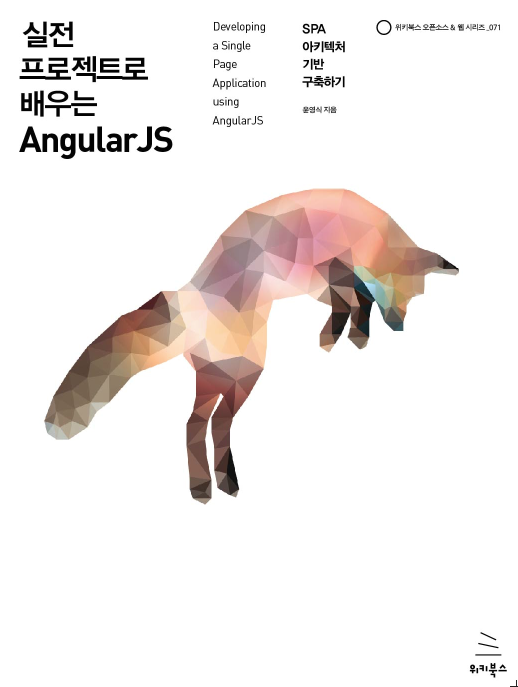Angular 최신 버전이 v5 beta-6를 향해 가고 있다. 9월에는 v5 release가 될 것으로 보인다. Angular에서 툴 기능으로 @angular/cli를 제공하고 있는데 오늘은 이것의 내부구조에 대해 연구해 본다.
@angular/cli 설치 및 프로젝트 생성
설치는 npm 또는 yarn을 이용한다.
$> npm i -g @angular/cli
or
$> yarn add global @angular/cli
Angular 기반 프로젝트를 생성해 보자.
$> ng new jamong
실행해 보자
$> ng serve
폴더 구조
설명에 따라 추가 명령을 수행한다.
$> npm run build && npm start
// package.json의 build 와 start 스크립트 설정내역
"scripts": {
"ng": "ng",
"start": "webpack-dev-server --port=4200",
"build": "webpack",
"test": "karma start ./karma.conf.js",
"lint": "ng lint",
"e2e": "protractor ./protractor.conf.js",
"pree2e": "webdriver-manager update --standalone false --gecko false --quiet"
},
webpack 오류가 난다면 webpack이 global설치가 않되어 있기때문이다. webpack을 설치한다.
$> yarn add webpack --dev
또는
$> yarn add global webpack
또는
$> npm install -g webpack
Webpack 환경파일
webpack의 기본은 초기 참조할 entry파일과 결과 번들파일을 지정하는 것이다.
$> webpack <entry file path> <output bundle file path>
예) webpack ./entry.js bunlde.js
간단한 번들링은 CLI를 사용해도 무방하지만 복잡한 옵션이 적용되어야 한다면 환경파일을 사용한다. 예) webpack.config.js 아래 예에서 ouput의 filename에 [name]은 entry의 'app' 키값이다.
module.exports = {
context: __dirname + '/app',
entry: {
app: './app.js'
},
output: {
path: __dirname + '/dist',
filename: '[name].bundle.js'
}
}
환경설정 자세한 옵션은 공식문서를 참조한다. 여기서 주의할 것은 entry는 String, Object, Array로 설정가능하다.
- String: 하나만 설정
- Array: output 번들링 파일에 순서적으로 합쳐진다.
- Object: SPA처럼 index.html에 적용되는 것이 아니라, index1.html 또는 index2.html 등 output이 각각의 html에 포함될 때 사용한다.
Webpack Loader
Webpack에는 자바스크립트가 아닌 확장형식의 파일을 자바스크립트에서 동작할 수 있도록 해주는 로더(Loader)가 있다. 즉, 모든(CSS, Images, HTML...)을 모듈로 취급하게 해주는 핵심역할을 로더가 수행한다. 말 그대로 다양한 파일 확장자의 Module Loader의 줄임말이라 보면된다. (전체 목록 참조) 만일 설정중에 module, rules를 사용하지않고 loaders를 쓰거나, options대신 query를 쓰면 webpack 1에 대한 설명이다.
- 스타일: style, css
- 변환: typescript, coffeescript, ES2015
환경파일안에 module 밑으로 설정한다.
module.exports = {
entry: ...
output: ...
module: {
rules: [
{
test: /\.css$/,
use: [ 'style-loader', 'css-loader']
}
]
...
}
}
특히 Angular 개발시에는 Typescript를 사용하므로 sourcemap을 남기려면 'source-map-loader'를 module 프로퍼티에 설정한다. (sourcemap에 대해 webpack3에서는 plugin으로 설정도 가능하다.) enforce 설정값을 "pre"로 하면 자바스크립트 변환전에 sourcemap 을 만든다.
{
"enforce": "pre",
"test": /\.js$/,
"loader": "source-map-loader",
"exclude": [
/(\\|\/)node_modules(\\|\/)/
]
}
개발시에는 Node.js기반의 webpack-dev-server를 통해 개발 페이지를 테스트할 수 있다. 옵션은 --inline (전체 페이지 리로딩) --hot (변경 컴포넌트만 리로딩)한다.
// 전체 및 부분 리로딩 옵션 설정
$> webpack-dev-server --inline --hot
Webpack Plugins
플러그인은 Output 번들의 Chunk 또는 Compilation 레벨 파일에 대한 추가 작업을 수행한다. 예로 ulgifyJSPlugin은 번들 파일 사이즈를 줄이고, 코드를 못 알아보게 만들어 준다. 또는 extract-text-webpack-plugin의 경우는 css-loader, style-loader의 결과를 하나의 별도 외부 파일로 만들어 준다. (플러그인 목록 참조)
@angular/cli에서 ng eject로 나온 webpack.config.js안의 plugins설정 내역
"plugins": [
new NoEmitOnErrorsPlugin(),
new GlobCopyWebpackPlugin({
"patterns": [
"assets",
"favicon.ico"
],
"globOptions": {
"cwd": path.join(process.cwd(), "src"),
"dot": true,
"ignore": "**/.gitkeep"
}
}),
new ProgressPlugin(),
new CircularDependencyPlugin({
"exclude": /(\\|\/)node_modules(\\|\/)/,
"failOnError": false
}),
new NamedLazyChunksWebpackPlugin(),
new HtmlWebpackPlugin({
"template": "./src/index.html",
"filename": "./index.html",
"hash": false,
"inject": true,
"compile": true,
"favicon": false,
"minify": false,
"cache": true,
"showErrors": true,
"chunks": "all",
"excludeChunks": [],
"title": "Webpack App",
"xhtml": true,
"chunksSortMode": function sort(left, right) {
let leftIndex = entryPoints.indexOf(left.names[0]);
let rightindex = entryPoints.indexOf(right.names[0]);
if (leftIndex > rightindex) {
return 1;
} else if (leftIndex < rightindex) {
return -1;
} else {
return 0;
}
}
}),
new BaseHrefWebpackPlugin({}),
new CommonsChunkPlugin({
"name": [
"inline"
],
"minChunks": null
}),
new CommonsChunkPlugin({
"name": [
"vendor"
],
"minChunks": (module) => {
return module.resource &&
(module.resource.startsWith(nodeModules) ||
module.resource.startsWith(genDirNodeModules) ||
module.resource.startsWith(realNodeModules));
},
"chunks": [
"main"
]
}),
new SourceMapDevToolPlugin({
"filename": "[file].map[query]",
"moduleFilenameTemplate": "[resource-path]",
"fallbackModuleFilenameTemplate": "[resource-path]?[hash]",
"sourceRoot": "webpack:///"
}),
new CommonsChunkPlugin({
"name": [
"main"
],
"minChunks": 2,
"async": "common"
}),
new NamedModulesPlugin({}),
new AotPlugin({
"mainPath": "main.ts",
"replaceExport": false,
"hostReplacementPaths": {
"environments/environment.ts": "environments/environment.ts"
},
"exclude": [],
"tsConfigPath": "src/tsconfig.app.json",
"skipCodeGeneration": true
})
]
JHipster로 자동생된 webpack.config.dev.js의 plugins 설정 내역
plugins: [
new BrowserSyncPlugin({
host: 'localhost',
port: 9000,
proxy: {
target: 'http://localhost:9060',
ws: true
}
}, {
reload: false
}),
new webpack.NoEmitOnErrorsPlugin(),
new webpack.NamedModulesPlugin(),
new writeFilePlugin(),
new webpack.WatchIgnorePlugin([
utils.root('src/test'),
]),
new WebpackNotifierPlugin({
title: 'JHipster',
contentImage: path.join(__dirname, 'logo-jhipster.png')
})
]
Production vs Development
개발과 운영 시점에 webpack 환경을 달리 적용하기 위해 보통 webpack.config.dev.js 와 webpack.config.prod.js를 따로 만들고 package.json의 script에 적용해 사용한다. package.json에 적용하고 싶지 않다며 gulp를 사용해도 된다.
@angular/cli의 script 내역
"scripts": {
"ng": "ng",
"start": "webpack-dev-server --port=4200",
"build": "webpack",
"test": "karma start ./karma.conf.js",
"lint": "ng lint",
"e2e": "protractor ./protractor.conf.js",
"pree2e": "webdriver-manager update --standalone false --gecko false --quiet"
}
JHipster script 내역
"scripts": {
"lint": "tslint --type-check --project './tsconfig.json' -e 'node_modules/**'",
"lint:fix": "yarn run lint -- --fix",
"ngc": "ngc -p tsconfig-aot.json",
"cleanup": "rimraf target/{aot,www}",
"clean-www": "rimraf target//www/app/{src,target/}",
"start": "yarn run webpack:dev",
"serve": "yarn run start",
"build": "yarn run webpack:prod",
"test": "karma start src/test/javascript/karma.conf.js",
"test:watch": "yarn test -- --watch",
"webpack:dev": "yarn run webpack-dev-server -- --config webpack/webpack.dev.js --progress --inline --hot --profile --port=9060",
"webpack:build:main": "yarn run webpack -- --config webpack/webpack.dev.js --progress --profile",
"webpack:build": "yarn run cleanup && yarn run webpack:build:main",
"webpack:prod:main": "yarn run webpack -- --config webpack/webpack.prod.js --progress --profile",
"webpack:prod": "yarn run cleanup && yarn run webpack:prod:main && yarn run clean-www",
"webpack:test": "yarn run test",
"webpack-dev-server": "node --max_old_space_size=4096 node_modules/webpack-dev-server/bin/webpack-dev-server.js",
"webpack": "node --max_old_space_size=4096 node_modules/webpack/bin/webpack.js",
"e2e": "protractor src/test/javascript/protractor.conf.js",
"postinstall": "webdriver-manager update && node node_modules/phantomjs-prebuilt/install.js"
}
to be continued...






